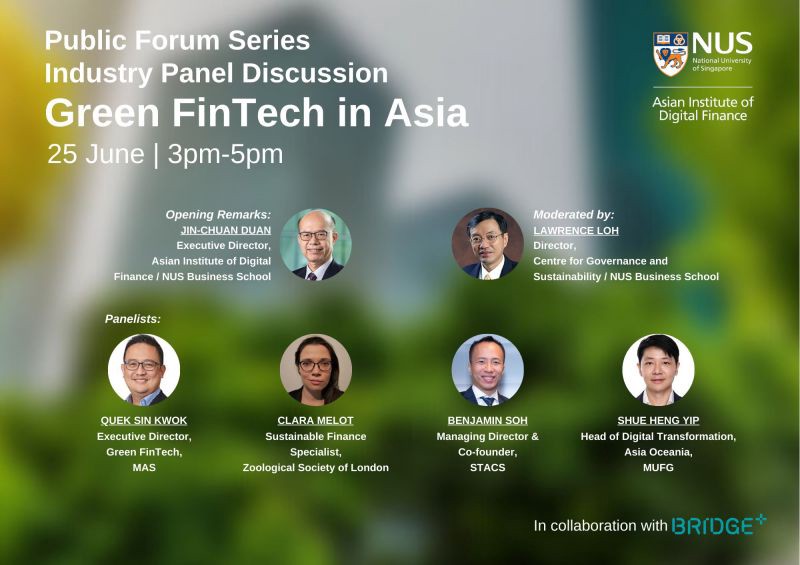Green FinTech in Asia — Key Highlights from Industry Panel organised by Asian Institute of Digital Finance, with STACS, Monetary Authority of Singapore (MAS), and more

Industry Panel Discussion — “Green FinTech in Asia”
In June, we were thrilled to be part of an industry panel on “Green FinTech in Asia” organised by the Asian Institute of Digital Finance.
STACS Co-founder & Managing Director, Benjamin Soh (‘Ben’), was joined by industry leaders for an in-depth discussion on the latest trends and applications in digital technologies in green and sustainable finance.

The hybrid nature of both speakers and audience added great value to the event. Benjamin Soh and Clara Melot joined the speakers at the event virtually.
In addition to Ben, the esteemed speaker lineup included Quek Sin Kwok, Executive Director of Green FinTech at Monetary Authority of Singapore; Clara Melot, Sustainable Finance Specialist at the Zoological Society of London; and Shue Heng Yip, Head of Digital Transformation for Asia Oceania at MUFG.
The session was moderated by the distinguished Lawrence Loh, Director of the NUS Centre for Governance and Sustainability at NUS Business School.
Read on for key insights from STACS’ perspective highlighted by Ben during the hour and a half discussion.
Bridging the US$2.5 trillion green funding gap
When we started out as a fintech company, our mission was mainly to serve the large financial institutions by providing them with innovative technology to make their back-end processes more efficient.
Within the last 12 months, we realised that many financial institutions are starting to move towards more green and sustainability goals, which resonates very well with who we are and what we do as a company.
The data shows that as of the end of last year, only 0.3 per cent of all bonds in the market are actually green.
Moreover, the total amount of green financing each year is only up to about US$1 trillion, despite the United Nations Sustainable Development Goals estimating an annual funding shortfall of US$2.5 trillion.
A majority of the funding (as much as 80 per cent) going towards sustainable projects is being contributed by the public sector, leaving a substantial gap that has to be filled by the private sector.
That’s where, as a fintech company serving largely the private enterprises in the financial sector, we started to see the convergence of the private financial sector and green investment to the point where, going forward, we expect all finance will be green in one form or another.
There are already some very interesting use cases out there, especially in Asia: we are starting to see sectors like transportation and logistics in Singapore, for example, which contribute 13 per cent of all greenhouse gases, becoming a big opportunity for the banks to finance the transition to more sustainable alternatives.
There needs to be technology collaboration among all stakeholders to provide better data infrastructure and monitoring technologies that enable financial institutions to make green financing quicker and more effectively.
Establishing a common green infrastructure for Singapore
There are a lot of green technologies out there already, especially here in Singapore where we have a world-class pool of innovative entrepreneurs (just look at some of the great incubated start-ups NUS and other research institutes have developed over the years as an example).
Today, there are easily a few hundred technology start-ups in Singapore that are solving real problems with real solutions, but that can also make it a fragmented landscape for financial institutions trying to find the right partner to work with on green fintech solutions.
With so much new technology out there, there isn’t really yet a green tech standard in place — this is one thing we need to overcome together by establishing some form of common data infrastructure or digital interface.
We’re very encouraged by what GovTech has achieved with its SingPass and CorpPass initiatives, which have provided a standard across various agencies (anyone who grew up in Singapore knows that this was not always the case).
That’s something that we are also striving towards as a fintech company because we believe we now need a common underlying infrastructure whereby we are able to support various types of innovative, exciting technologies on a common project source.
This will allow the industry at large, including all the tech companies and banks, to better monitor the progress of green projects and ensure financing is not just green at the point of application (i.e. of a loan), but also throughout the entire life cycle.

The event was hosted at the beautiful space at Bridge+, 79 Robinson Road.
This will allow the industry at large, including all the tech companies and banks, to better monitor the progress of green projects and ensure financing is not just green at the point of application (i.e. of a loan), but also throughout the entire life cycle.
Preventing greenwashing in cross-border transactions
As a Singaporean fintech firm, we understand that Singapore is a relatively small part of a much larger ASEAN region with over 650 million people.
It should come without surprise, therefore, that many Singapore companies, including the local banks, have global exposure in countries across the region.
When a Singapore-based company hands over a relationship to another bank or party in another market, we need to be able to verify the authenticity of all the data that goes with that in order to be fully transparent.
That’s where we believe our implementation of the blockchain to verify, authenticate, and automate (through the use of smart contracts) certain actions when certain conditions are met is key.
Vice versa, our technology triggers notifications when tampering has taken place, effectively preventing greenwashing.
By using these technologies in a collaborative spirit, we are better able to cross borders without sacrificing the effective tracking of source data in the financial sector.
COVID: a positive force for green change
Over the past year, COVID has undoubtedly brought about a change in mindsets.
In the finance sector especially, we used to have to do a lot of in-person meetings and demonstrations, with long processes involved just to get started on projects.
With COVID, there’s now a new normal that has made it acceptable to see each other virtually, which has been very helpful to getting projects and tech implementations off the ground.

The engaging session concluded with a Q&A segment, with questions taken from both the physical and virtual audience.
Ultimately, to achieve these green goals over the coming decade require changes across the board — everything from consumer behaviour to new incentives and penalties that align with ESG-based outcomes.
We see technology as an enabler and financial institutions as the facilitator, which means there will be a very real coming together of “fin” and “tech” if we hope to create lasting green change in consumer and corporate behaviour for a better planet.
PRESS CONTACTS
If you are a journalist with media queries, contact us.




